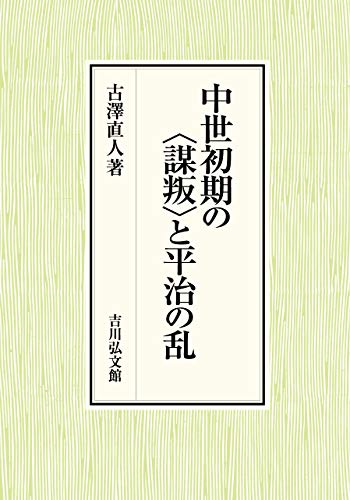31 0 0 0 IR 平治の乱における源義朝謀叛の動機形成 : 勲功賞と官爵問題を中心に (長部重康教授退職記念号)
- 著者
- 古澤 直人 Furusawa Naoto
- 出版者
- 法政大学経済学部学会
- 雑誌
- 経済志林 (ISSN:00229741)
- 巻号頁・発行日
- vol.80, no.3, pp.129-187, 2013-03
The accepted theory about the Heiji Disturbance has been rejected timeand again sincethe 1980s, especially in 2004 and afterwards by Mr. Yasuo Motoki. The first aim of this monograph is to test Mr. Yasuo Motoki's theory. The second is to investigate the formation of the motives behind the Yoshitomo Rebellion in the Heiji Disturbance. (1) As a result ofverifying and evaluating the historical context, the Motoki theory proved tobe mistaken. The prize to Yoshitomo should be estimated as being "too small". (2) The account in "Gukansyo (愚管抄)" of Yoshitomo is reliable, and when we consider Yoshitomo's rebellion, we should think of the problem betweenYoshitomo and Kiyomori (清盛) not as being between individuals but rather as a problem between <families>, and must fully respect "Gukansyo". (3)Speaking of the marriage issue between the Yoshitomo family, the Kiyomori family andthe Sinzei (信西) family,Yoshitomo proposed to the 3rd son of the Sinzei family, but was rejected by Sinzei. After that, Yoshitomo was immediately confronted with a marriage between the Sinzei and Kiyomori families. This incident damaged Yoshitomo's self-respectand this is presumed to have greatly increased Yoshitomo's hostility towards both Sinzei and Kiyomori. (4) Although there had been clear differences between the Yoshitomo and Kiyomori families before the Hougen Disturbance, these differences spread steadily after the Hougen Disturbance in spite of Yoshitomo's acts of courage. It is presumed that Yoshitomo held the view that the situation with regard to the Kiyomori family could not be recovered through the usual means.
23 0 0 0 IR 平治の乱における藤原信頼の謀叛 : 再評価と動機形成をめぐって
- 著者
- 古澤 直人 Furusawa Naoto
- 出版者
- 法政大学経済学部学会
- 雑誌
- 経済志林 (ISSN:00229741)
- 巻号頁・発行日
- vol.80, no.4, pp.283-337, 2013-03-15
Nobuyori Fujiwara has not been considered a powerful figure in Japan's history, but, thanks to Mr. Yasuo Motoki's reappraisal of Nobuyori since 2004, our understanding has changed and Nobuyori Fujiwara is now judged to have exerted much more power than we thought. In current academic circles, Motoki's views exert a strong influence. This paper is part of the writer's research on the rebellion, and an investigation of the motives behind the rebellion is its first aim. To test Mr. Motoki's ideas is the second. The results are as follows.(1) The reappraisal of Nobuyori Fujiwara cannot be supported.(2) In considering the rebellion, Nobuyori and Shinzei (信西) should not be considered as individuals but as <families>, and we should follow the descriptions given in "Gukansyo (愚管抄)".(3) It seems that Nobuyori felt a sense of crisis before the many able sons of the Shinzei family and when he looked at the next generation, he could not regain the status quo ante through the usual means. (4) The Shinzei family's advance into aristocratic circles evoked strong animosity, especially towards the 2nd or 3rd sons of the middle class aristocratic family. This is presumed to be the background against which Korekata (惟方) and Narichika (成親) and other participants joined forces in the rebellion.
5 0 0 0 OA 日本 : 中世 三(一九九〇年の歴史学界 : 回顧と展望)
- 著者
- 古澤 直人
- 出版者
- 公益財団法人 史学会
- 雑誌
- 史学雑誌 (ISSN:00182478)
- 巻号頁・発行日
- vol.100, no.5, pp.687-690, 1991-05-20 (Released:2017-11-29)
- 著者
- 古澤 直人
- 出版者
- 法制史研究
- 雑誌
- 法制史研究 (ISSN:04412508)
- 巻号頁・発行日
- vol.1996, no.46, pp.127-146, 1996
2 0 0 0 OA 二条天皇の六波羅行幸をめぐって
- 著者
- 古澤 直人
- 出版者
- 法政大学多摩論集編集委員会
- 雑誌
- 多摩論集 = 多摩論集 (ISSN:09112030)
- 巻号頁・発行日
- vol.34, no.別冊, pp.79-87, 2018-03
1 0 0 0 中世初期の「謀叛」と平治の乱
1 0 0 0 OA 平治の乱の要因と12月9日事件の経緯について : 河内祥輔氏の学説検討を手がかりにして
- 著者
- 古澤 直人
- 出版者
- 法政大学経済学部学会
- 雑誌
- 経済志林 = 経済志林 (ISSN:00229741)
- 巻号頁・発行日
- vol.80, no.4, pp.339-380, 2013-03-15
This paper considers factors in the Heiji Disturbance and the circumstances of a nine-day incident through an examination of the theory of Mr. Syousuke KAWACHI (河内祥輔). The conclusions are as follows.(1) The situation in aristocratic circles after the Hougen Disturbance was not stable.(2) The confrontation between a direct Imperial government group and a cloister government group began from the time of GOSHIRAKAWA’s (後白河) abdication from the throne.(3) Mr. KOUCHI pointed out the motives of the original Crown Prince in the lead-up to the nine-day incident, but there are no historical records that can establish the truth about “GOSHIRAKAWA’s intentions.”(4) It was not a “fire due to negligence” but “arson” in the case of the SANJOUDONO (三条殿) fire during the nine-day incident. Retired emperors were moved to the Imperial Palace because of the “arson”, and the SHINZEI (信西) family’s influence was eliminated at the same time.(5) Evidence of GOSHIRAKAWA’s hatred of SHINZEI is thin.(6) The joint conspiracy to exclude the SHINZEI family continued until February 20th the following year.(7) There was no theory that clearly drew a connection in the rebel forces from NOBUYORI (信頼) to GOSHIRAKAWA. (8) The SHINZEI family’s isolation is due to the fact that the main characters in the nine-day incident were anti-SHINZEI groups. (9) The account of the incident was re-written 25 or 26 days afterwards, but this was not done to conceal GOSHIRAKAWA’s intentions but to water down the extent of TUNEMUNE (経宗) and KOREKATA’s (惟方) participation.

